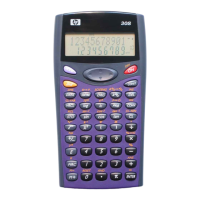hp calculators
HP 30S Converting Angles and Times
Angle measurements
The amount of turning between two rays with a common origin, or the measure of change of direction, is what we call an
angle. Angles cannot be measured in meters or yards. As measures of the amount of turning, we use degrees, radians
and grads.
A
degree is one 360th of a complete turn and its symbol is º. Just like a meter which has
multiples and submultiples (e.g. kilometer, millimeter, etc), degrees are broken down into
minutes and seconds. The
minute (‘) is one sixtieth of a degree, and the second (‘‘) is one
sixtieth of a minute. The
radian is defined as the angle subtended by an arc of a circle of length
equal to its radius (see figure 1). Its symbol is
C
(but this symbol is not widely used). Note that
the counterclockwise direction of turning is taken to be positive. Grads are a measure of angle
equal to one hundredth of a right angle. Grads are also known as gradians and grades. Angle
units can be easily converted since:
dsgradegreesradians 4003602
It is important to understand that there are two ways of expressing an angle in degrees: using decimal degrees and
using degrees, minutes and seconds. In decimal degrees, an angle is simply given as 33.5 degrees, that is to say, 33
degrees and a half. In the degrees, minutes, seconds (or DMS) format, the same angle is 33 degrees, 30 minutes.
The HP 30S can work with angles in either measurement system and provides the DRG ( c) and DMS ( —A)
menus to convert between them. It also has theDMS function (—A<y) which is useful in converting
between the two formats of angles expressed in degrees.
Time measurements
As units of time, a minute is equal to 60 seconds and a second (abbreviated as s) is the fundamental unit of time in the
SI system. Since an hour has 60 minutes, a useful application of the conversion between decimal degrees and DMS
angles is that the exact same conversion can also work for time. A measurement of 10.5 hours can be converted into 10
hours and 30 minutes by the same process by which an angle of 10.5 degrees can be converted into 10 degrees, 30
minutes (i.e. using the same function, DMS)
Practice solving problems involving angles and times
Example 1: Convert an angle of 25 degrees into radians.
Solution: Like many other calculators, the HP 30S operates in an angle mode that the user should specify before
doing certain calculations such as trigonometric functions and coordinate conversions. Such mode can be
selected in the DRG menu. Press c and use the < and @ keys to select the desired mode, in this
case, select RAD and press y. The RAD annunciator is lit . Now , all angles will be in radians unless
stated otherwise. We need to enter 25 degrees, so we must find a way of telling the calculator that this
angle is not expressed in radians. This is done by placing the degree symbol (º) after the quantity 25, and
such symbol is in the DMS menu. Press:
25—Ay
hp calculators - 2 - HP 30S Converting Angles and Times - Version 1.0

